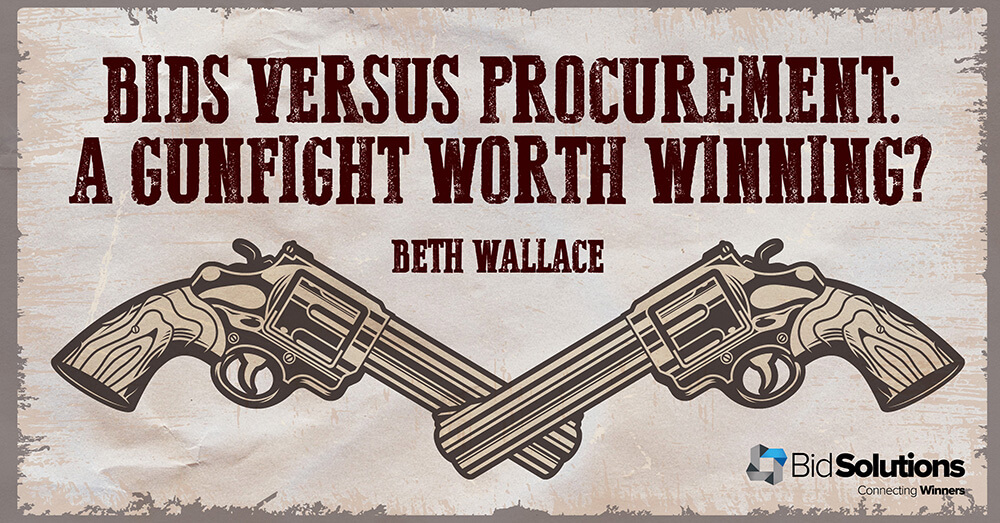
“Oh great?!”, I can hear you think. “The procurement person’s article… this will be fun. Not.” (as you look around for a pile of rocks or knives to throw).
Well, I could do the same. By way of prep for this article, I asked a few Procurement colleagues to give me their experiences of the good, the bad and the ugly of proposals over the years. Out came a barrage of bads and uglys – but no goods.
- The lady whose nervous tic in a presentation was applying her bright red lipstick as she spoke – I remembered it and the colour vividly but had no recollection of what the pitch was about.
- The time the ill-prepared salesperson pitching the presentation ran out to the car park in full view of the client and downloaded a bog standard (but unfortunately also animated) presentation to pitch with. The client had the embarrassment of seeing their logo disappear in a hail of gunfire bullets as his disastrous talk progressed.
- The proposals with loads of grammar and punctuation issues to the point it was unreadable and thrown out. And also – particularly ugly to us Procurement folks – the obvious cut and paste ones, especially those forgetting to change the client’s name.
See? We have our pile of rocks ready too.
But what does that do, other than re-enforce the collective stereotypes we have? I therefore thought to focus this article on what makes the difference. Why would a pitch document make me choose you over your competition? The simple answer is: you know when you read a great proposal document that the potential supplier just “gets it”. The struggle is not finding the right points to score against the criteria but thinking why full marks would not be accredited. I appreciate this is not always obvious so let me explain further:
- The work to understand what we are trying to achieve and how the client ticks before any document goes out might be weeks or months in advance of any need for a proposal to be written. This should include Procurement. I always recommend you at least think about them when creating your client stakeholder map. Also, do not forget governance in some sectors might dictate more formally how you can liaise with your client; done correctly this could potentially help you influence the final scope of the pitch.
- The really ‘on point’ clarification questions or requests. These are not the “Can we exceed the word count?” type or the ones that ignore the remit entirely and try to fit the supplier solution square peg in the client round hole. These are the ones that make the client think about its scope and what it wants, particularly in a potentially complex transaction. Often the scope is created by a team including technical, operational and procurement resources in tight timescales dictated by business needs rather than Procurement. Whilst it should all naturally make sense, sensible challenging of the requirements is definitely welcomed.
- The cultural fit between the two organisations – the certainty the two companies could work together for a common goal rather than a separate sales (or even savings) target. Strangely, this also includes following the rules of the procurement process at play for the pitches. Yes, that does mean not including marketing bumf or making sure every question is answered but also includes lines of communication between the parties. When a potential supplier does not follow simple instructions – no matter how frustrating they may seem – it introduces an element of nervousness (or indeed risk) into the relationship before it has even started. It always has a negative impact on the scoring.
- Would you believe I also have a great deal of respect for suppliers who say no to pitching at all? It might not be for you, it is not economical, the requirement does not make sense, it might not fit your strategic direction, you do not think you would have a great chance of winning and thus need to focus on more certain pitches. All of these are valid reasons. Good clients – including the client’s Procurement team – should be having those early conversations to gauge appetite. If that has not happened and the document has just been sent out, you will know better than me how it impacts your success rate. I would rather receive a smaller number of great proposals than a load of mediocre or even poor ones to review.
What else might make a difference? I know there are discussions in your profession about further best practice standards. From my perspective, improving best practice would not do any harm – but making it too standard might make it more difficult for the client to see clear blue water between the various proposals. This would be no different to a Procurement person downloading some of the templates and processes from our Chartered Institute of Purchasing and Supply website. These are helpful as a starting point but you will all have examples where the issued tender document is about buying widgets rather than services. How infuriating is that for you to read? The same would be true in the reverse.
For me, the differentiator is absolutely the quality of the written document. There is so much more but that at least gets you in the door. It is up to you to do the rest.
This article was written by Beth Wallace.
Beth has worked in a number of sectors, starting out in aerospace manufacturing but also working in financial services, media, hospitality and legal to name a few.
Her career has spanned both negotiating deals as well as managing supplier relationships, from simple projects to complex outsourcing.

